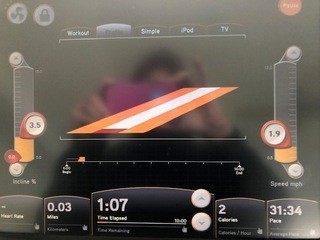Phase 2 of Peripheral Arterial Disease
Week #5
Last week’s focus was on Phase 1 of peripheral arterial disease (PAD) which often first manifests itself as a non-healing wound on the distal toes. Phase 2 of PAD is characterized by pain, aching, fatigue, or cramping in the lower extremity muscles with a definite and measurable amount of exercise, as a result of decreased availability of oxygen to the muscles as the work load increases. Until recently, PAD was not recognized as a diagnosis treated by physical therapists; however, the clinic where I worked obtained verbal approval from Centers for Medicare and Medicaid Services (CMS) to use a diagnosis of leg pain. In 2017, CMS issued a decision that physical therapy would be covered for supervised exercise therapy (SET) for patients who were experiencing intermittent claudication due to PAD. The decision is based on evidence that SET is the most effective treatment for intermittent claudication because of the collateral circulation that is synthesized as a result of the increased oxygen demand during exercise. Elements of an approved SET program include the following:
- Physician referral is required based on a face-to-face visit with the patient.
- Up to 36 sessions are covered in a 12-week period.
- Services must be delivered in a hospital-based outpatient clinic or a physician office setting.
- Direct supervision must be provided by a MD, PA, PT, or nurse practitioner/clinical nurse specialist.
Physical therapists are especially qualified to treat PAD patients with leg pain because of their ability to make a differential diagnosis based on signs, symptoms, and functional activity impairments. One common differential diagnosis is to determine if the pain is vascular or neurogenic. Vascular pain will be identified by the following:
- Diminished pulses with an ankle/brachial index between 0.41-0.9.
- Pain that resolves with cessation of the activity without necessarily changing position (like sitting down)
- Typically begins slowly and progresses over time.
- Location of pain is relative to location of the arterial occlusion (e.g. calf: popliteal or superficial femoral arteries; thigh: iliac or proximal femoral arteries; buttock: aorta or proximal iliac arteries)
Pain associated with lumbar spinal stenosis (LSS) is very similar to intermittent claudication due to PAD in that it causes a similar pattern of pain and fatigue with walking (a lumbar extension activity). It can be differentiated by asking the patient “What makes the pain go away?” or observing patient in ADLs. LSS pain can occur with standing only without walking, and relief from the pain usually requires a change in position (such as standing to sitting or to a flexed lumbar position) rather than just ceasing the activity. And indeed, the treatments for the two maladies are completely different!
A SET program for vascular-related intermittent claudication usually involves 12 weeks of training with 30- to 60- minute sessions. A baseline of maximal walking distance, speed, and incline on a treadmill until moderate pain occurs with 3-5 minutes of exercise is first determined, as well as the amount of time for symptoms to resolve. Careful monitoring of cardiac vital signs (BP and pulse) is advised since these patients frequently have cardiac involvement and/or hypertension.
Treatment involves having the patient walk until pain is 7-8/10, rest until pain subsides, and then repeat the process throughout the session, at least 2 times, preferably more. Some studies suggest that increasing the incline of the treadmill is more important than speed or distance as this increases the work load on the gastroc-soleus muscles and thereby stimulates more collateral circulation. Gardner et al recommended a constant speed of 3.2 km/h, with a 2% increase in incline every 2 minutes. All parameters can be altered for patient tolerance. The 6-minute walk test is a good objective tool to measure improvement, as well as patient reports of improved function and quality of life. My experience is that it usually takes at least 3 weeks for the patient to achieve an increased functional capacity without pain. And amazingly, the collateral vessels can be visualized on duplex scans. Prevention of distal tissue loss (i.e. wounding) by improving circulation is “the icing on the cake” for involving patients in a SET program!
More information on evaluation and treatment of intermittent claudication due to PAD may be found in the following references:
Gardner AW, Skinner JS, Cantwell BW, Smith LK. Progressive vs single-stage treadmill tests for evaluation of claudication. Med Sci Sports Exerc. 1991;23:402-408.
Jewell DV, Shishehbor MH, Walsworth MK. Centers for Medicare and Medicaid Services policy regarding supervised exercise for patients with intermittent claudication: The good, the bad, and the ugly. Journal of Orthopaedic & Sports Physical Therapy. 2017;47(12):892-894.
Walsworth MK, de Bie R, Figoni SF, O’Connell JB. Peripheral artery disease: What you need to know. Journal of Orthopaedic & Sports Physical Therapy. 2017;47(12):957-964.
More about PAD and arterial wounds is available at the following:
Woelfel S, Ochoa C, Rowe VL. Vascular wounds. In Hamm R (Ed), Text and Atlas of Wound Diagnosis and Treatment: 2nd edition. New York: McGraw Hill Education. 2019, 101-143. Available at https://accessphysiotherapy.mhmedical.com/book.aspx?bookid=1334.







Create a Free MyAccess Profile
AccessMedicine Network is the place to keep up on new releases for the Access products, get short form didactic content, read up on practice impacting highlights, and watch video featuring authors of your favorite books in medicine. Create a MyAccess profile and follow our contributors to stay informed via email updates.